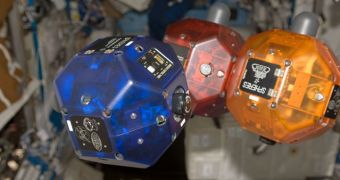Obviously and admittedly inspired by the Training Remotes concept (the small droid spheres that helped Luke Skywalker perfect his lightsaber skills) from Star Wars, three autonomous spheres are roaming around the International Space Station. They're even called SPHERES, but not because of an off-moment in terms of imagination for their Massachusetts Institute of Technology (MIT) developers. It actually stands for Synchronized Position Hold, Engage, Reorient, Experimental Satellites.
The small drones, each the size of a bowling ball (8 inches / 20 centimeters in diameter), are self-sustaining when it comes to power (batteries), fuel (carbon dioxide), propulsion (12 thrusters), computers, guidance and navigation tools.
The small robots, coming in 3 different colors (as seen in the picture), are used as prototypes, paving the road for the spacecraft to come. In a hazard-free environment, they are testing potential behavior of future probes in that which concerns maneuverability, formation flight and operations, metrology, autonomy, supervision, and control of high-risk tasks (like docking or maintenance operations). Based on their behavior and the data they provide, technicians will build better, more reliable crafts and software that could deal with operating multiple such objects at once.
The bigger, more advanced and better equipped final versions of the SPHERES would prove to be far more cost-efficient, and better suited for difficult or redundant tasks. Unlike an actual modern space shuttle, launching these microsatellites into the skies would virtually cost almost nothing, since they could tag along inside larger ships, as those are sent into the outer space. They could perform routine maintenance missions, behave as a planet-finding interferometer or supervise docking operations, acting as groups.
They could even lend support to the circulated idea of building a spaceship directly on Earth's orbit, bit by bit. Moreover, if something goes wrong with one, another would take its place immediately, reorganizing the formation's positioning and further carrying on the pre-established task. But a final version is still far from being ready, so seeing them in action will just have to wait for now.

 14 DAY TRIAL //
14 DAY TRIAL //